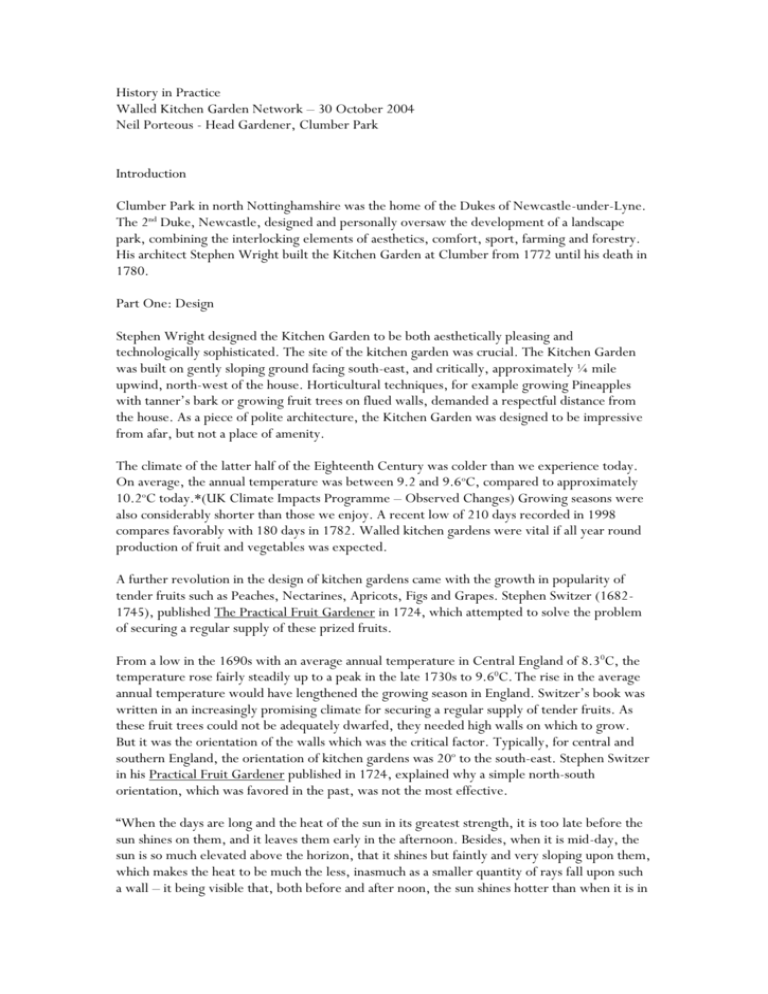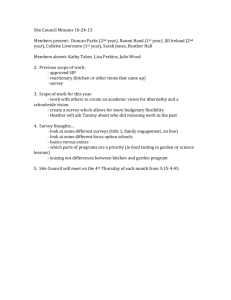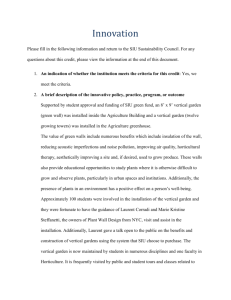History in Practice - Walled Kitchen Gardens Network.
advertisement

History in Practice Walled Kitchen Garden Network – 30 October 2004 Neil Porteous - Head Gardener, Clumber Park Introduction Clumber Park in north Nottinghamshire was the home of the Dukes of Newcastle-under-Lyne. The 2nd Duke, Newcastle, designed and personally oversaw the development of a landscape park, combining the interlocking elements of aesthetics, comfort, sport, farming and forestry. His architect Stephen Wright built the Kitchen Garden at Clumber from 1772 until his death in 1780. Part One: Design Stephen Wright designed the Kitchen Garden to be both aesthetically pleasing and technologically sophisticated. The site of the kitchen garden was crucial. The Kitchen Garden was built on gently sloping ground facing south-east, and critically, approximately ¼ mile upwind, north-west of the house. Horticultural techniques, for example growing Pineapples with tanner’s bark or growing fruit trees on flued walls, demanded a respectful distance from the house. As a piece of polite architecture, the Kitchen Garden was designed to be impressive from afar, but not a place of amenity. The climate of the latter half of the Eighteenth Century was colder than we experience today. On average, the annual temperature was between 9.2 and 9.6oC, compared to approximately 10.2oC today.*(UK Climate Impacts Programme – Observed Changes) Growing seasons were also considerably shorter than those we enjoy. A recent low of 210 days recorded in 1998 compares favorably with 180 days in 1782. Walled kitchen gardens were vital if all year round production of fruit and vegetables was expected. A further revolution in the design of kitchen gardens came with the growth in popularity of tender fruits such as Peaches, Nectarines, Apricots, Figs and Grapes. Stephen Switzer (16821745), published The Practical Fruit Gardener in 1724, which attempted to solve the problem of securing a regular supply of these prized fruits. From a low in the 1690s with an average annual temperature in Central England of 8.3 0C, the temperature rose fairly steadily up to a peak in the late 1730s to 9.60C. The rise in the average annual temperature would have lengthened the growing season in England. Switzer’s book was written in an increasingly promising climate for securing a regular supply of tender fruits. As these fruit trees could not be adequately dwarfed, they needed high walls on which to grow. But it was the orientation of the walls which was the critical factor. Typically, for central and southern England, the orientation of kitchen gardens was 20o to the south-east. Stephen Switzer in his Practical Fruit Gardener published in 1724, explained why a simple north-south orientation, which was favored in the past, was not the most effective. “When the days are long and the heat of the sun in its greatest strength, it is too late before the sun shines on them, and it leaves them early in the afternoon. Besides, when it is mid-day, the sun is so much elevated above the horizon, that it shines but faintly and very sloping upon them, which makes the heat to be much the less, inasmuch as a smaller quantity of rays fall upon such a wall – it being visible that, both before and after noon, the sun shines hotter than when it is in its highest meridian-whence it is natural to infer, that walls with a little inclination, either to the east or west, are the best aspects; and of the two, the east and south-east are to be preferred to the west or south-west, though they are as much exposed to the sun as east walls are. In my opinion, a south wall, inclining about 20o to the east, is preferable to any other, inasmuch as the sun shines as early on it as on a full east wall, and never departs from it till about two O’clock in the afternoon.” P.312 This orientation then, gave the two warmest hours of the day for ripening tender fruits, like Peaches, Nectarines, Figs etc. That is between 11AM to noon and between 1PM and 2PM in the afternoon. During mid-day to 1PM, the sun was too high above the horizon to warm the walls effectively, especially as temporary coping, inclined 9” boards, were bolted to the walls from January to the end of May and from the end of August to October to increase the growing season for two to three weeks. After 3PM, the westering sun lit up the north sides of walls, providing enough light and warmth to ripen culinary crops, like cooking Apples or Morello Cherries. By 1755 the average annual temperature had dropped back to 9.20C and Switzer’s favoured orientation was still generally in favour. Thomas Hitt (d1770), published A Treatise on Fruit Trees that year and came up with an improvement to Switzer’s orientation which recommended having no direct south wall at all and arranged his kitchen garden as a rhomboid with two of its angles orientated north-south. Several of these kitchen gardens were built in the latter half of the Eighteenth Century, but the majority favoured Switzer’s arrangement, albeit with slight variations. In response to the shorter growing seasons and the continued demand for tender fruits, gardeners had two recourses, which were often employed simultaneously: flued walls and temporary coping. The branches of the fruit trees were “nailed and tagged” on to the brick work of the wall. A shred of cloth was wrapped around the shoot and fixed with a lead nail into the soft lime mortar of the pointing. The idea of flued walls to protect tender fruit had been known to the Romans, but in Britain a posthumous publication by Sir Hugh Platt of 1608, Floraes Paradise, first suggested the growing of fruit on the backs of chimneys. By 1750 flued walls were becoming a feature of kitchen gardens. There was continuous innovation and refinement simply because the transmission of heat to the brick was uneven causing cold areas, and more damaging still, hot-spots. The flues were lit from brick-lined pits behind the walls and the hot smoke would radiate its heat through the brick work. The flues were heavily rendered to prevent poisonous gasses damaging the tender foliage. Initially the flues were lit from February to protect the blossom, to May and then re-lit from the end of August to October to ripen any late fruit, but more usually to ripen the wood to allow flowering the following February. One danger was over heating the walls and damaging any tender young growth. By 1820 most new hot walls employed hot water which constituted a 90% increase in efficiency. Temporary coping was employed all year round with Peach trees to create a favourable microclimate around the branches and to shed water from the trees which would cool down the fruit and wood in summer and help prevent disseminate the spores of the fungus which caused Peach Leaf Curl in the winter. For the other wall fruit, planks were fixed from the permanent stone coping at an angle to shed water from the beginning of February to protect the blossom. Thin material, muslin or “scrag” was hung from hooks at night to prevent cold air pressing against the delicate blossom. The temporary coping was removed in May and put up again at the end of August to October which was said to extend the growing season by two weeks. The practice of tying fruit trees to the walls with shreds and nails was in decline by 1850 and increasingly, gardeners favoured using vine-eyes which held copper or iron wire half an inch from the wall. Back at Clumber, Stephen Wright went to some trouble to ensure the design of the Kitchen garden was correct. His bill to Newcastle for the year 1772 included, “To time in four journeys to Clumber and one to Blenheim about the Hott walls”, and “Drawing of the Hott walls as from Blenheim.” Wright was anxious not to incur the expense of building too many flued walls for the Kitchen garden, so he exaggerated Switzer’s prescription of 20o to the south-east to 28o. This had the effect of exposing his walls to more low sunlight in the morning, which would be stored by the brickwork and more direct sunlight to the culinary fruits on the north side of the wall in the evening. It may be that Wright reasoned that by doing this, the northerly aspect would lose less heat than it would otherwise and obviate the necessity for flued walls. One problem of positioning a walled garden on a gentle slope was that of the walls retaining cold air and frost, rather like water would be held by a dam. The cold air banked up to the height of the walls, and then backed up over the open quarters where the produce was grown. Wright’s solution was ingenious. Instead of building the unheated walls running east-west at an even height, he designed these walls in 16 sections, strengthened by piers. From the open, central axis, each section to both east and west was 3” lower than its outer neighbor. As a result, the outer sections may hold back 2’ more of cold air than the central sections. This extra weight of cold air at the edges would through gravity and diffusion, move towards the central axis where it could slip down the slope and exit the garden. The central axis was the coldest part of the garden and was a gravel path. As the cold air flowed away from the open quarters, the moving air became energized and was less likely to damage the growing crops it passed over. Wright was able to limit the quantity of flued wall in the garden to two short sections in the middle of the garden and two 70 yard sections along the north wall of the garden. To the south of these flued walls he would build stove houses. Part Two: Experiments Oak Leaves: William Speechley brought the Grape variety “Black Damascus” to Clumber from neighbouring Welbeck Abbey.* (‘Sherwood’, The Garden, 5th April 1873). Newcastle did not subscribe to his first work, “A Treatise on the Culture of The Pineapple and the Management of the HotHouse,” published in 1779, but bought two copies of his later work on the Vine, published in 1790. John Gee, the gardener at Clumber had died in 1784 to be replaced by John Wadie. Speechley was a very gifted gardener and could at times appear superior and arrogant. He experimented by forcing pineapples in beds of Oak leaves instead of the comparatively expensive and unpredictable tanner’s bark. Speechley reckoned that Leaves would release their steady heat for two seasons.*(Pineapple p.90 1779) Perhaps John Gee did not like Speechley because when he had problems with his Forcing Stoves, growing Pineapples in tanner’s bark, he turned to a Mr Bowles for help. It was left to John Marson to adapt his advice. Leek Bulbs: In The Gardener’s Magazine of 17th April 1875, it was suggested that unused Leeks could be used to produce a delicate and comparatively unknown vegetable, Leek Bulbs. “In the first place, clean the ground and hoe the surface to admit the showers to the roots and cut the tops of the flags, but not severely. In the course of a short time, the pointed scapes or flower-heads will appear. Pinch them out the instant they can be got, for not one must be allowed to rise. This pinching out will have to be done again and again, for scapes will show themselves to the last. When the flags begin to wither lift the roots and you will find that the old bulb (or Leek proper) has perished and in its place are two or three silvery bulbs of the size and shape of the largest tulips, attached to the withered stem. These underground bulbs may be kept some time, and may be useful in the place of Onions. But the way to understand their real value is to stew them in gravy and eat them hot with butter and pepper.” Brassicas and Legumes: One recent problem has been a 30% rise in some areas of the population of wood pigeons and Collared Doves. The area of the open quarters typically devoted to each crop type can be worked out from an Eighteenth Century work by a market gardener from Edinburgh. A nurseryman and florist, James Gordon of Fountainbridge published The Planters, Florists, and Gardeners Pocket Dictionary in 1774. In his work he detailed the amount of seed of each type a kitchen garden of one acre would need to keep a typical family in produce all year round. In 1853 Charles McIntosh was still quoting Gordon’s proportions as a useful guide for the young head gardener. Peas took up the most ground, closely followed by Brassicas of all kinds. Turnips were next along with Asparagus, Sea-Kale and Rhubarb for forcing. Potatoes would occupy a small part within the kitchen garden, early crops only, the rest being field grown outside the walls in less highly manured ground. Carrots, Leeks and Onions follow then Celery and Spinach. Spinach would only be grown in the gardens of the upper class and upper middle class. Broad beans, French or kidney beans and Scarlet Runner Beans would be next. Of the Beans, Broad beans were considered “flatulent” and tended not to be grown in the gardens of those with discerning palettes. Parsnips, Globe Artichokes and Beetroot were next in order followed by Parsley, Endive, Salsify, Skirret, Scorzonera, Jerusalem Artichokes, Garlic, Shallots, Rocambole, Succory or Chicory, Chervil “and all manner of pot and sweet herbs.” Lettuce did not appear on the list because it was grown opportunistically “in sheltered places, by the bottom of walls Etc.” Mixing age of Seed for Succession: The guiding principle was that each garden was cropped with a view to providing some fresh produce every day of the year. To this end crops were grown for succession and gardeners knew that one year old seed matured quicker than two year old and that by mixing the age of the seed to include three year old and even four year old seed, the cropping period of a given sowing could be extended.1 1. Charles McIntosh, The Book of the Garden. (Edinburgh & London: William Blackwood, 1853), Vol. II, p. 10. “In the meanwhile, let us endeavour to set aside the too prevalent opinion that seed of the previous year’s growth alone should be sown…The honest seedsman does an act of great kindness, and confers an important benefit on his customers, when he mixes the seeds of 1851, 1852 and 1853 together:” NP29/10/04









